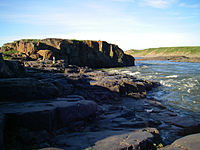Coppermine River
| Coppermine River | |
|---|---|
 View of the Arctic Sea from the mouth of the Coppermine River (1821) byGeorge Back | |
| Location | |
| Country | Canada |
| Physical characteristics | |
| Source | Lac de Gras |
| • location | Northwest Territories,Canada |
| • coordinates | 64°35′01″N111°11′33″W/ 64.58361°N 111.19250°W |
| • elevation | 396 m (1,299 ft) |
| Mouth | Coronation Gulf |
• location | Nunavut,Arctic Ocean,Canada |
• coordinates | 67°48′43″N115°05′05″W/ 67.81194°N 115.08472°W |
• elevation | 0 m (0 ft) |
| Length | 845 km (525 mi) |
| Basin size | 50,700 km2(19,600 sq mi) |
| Discharge | |
| • average | 337.69 m3/s (11,925 cu ft/s)[1] |
| • minimum | 10.37 m3/s (366 cu ft/s) |
| • maximum | 1,500 m3/s (53,000 cu ft/s) |
| [2][3] | |
TheCoppermine Riveris a river in theNorth SlaveandKitikmeotregions of theNorthwest TerritoriesandNunavutinCanada.It is 845 kilometres (525 mi)[4]long. It rises inLac de Gras,a small lake nearGreat Slave Lake,and flows generally north toCoronation Gulf,an arm of theArctic Ocean.The river freezes in winter but may still flow under the ice.
The community ofKugluktuk(formerly Coppermine) is located at the river's mouth.
The river was named for thecopperores which are located along the river, bySamuel Hearnein 1771.[5]Hearne found only one lump of copper and commercial mining was not considered viable.[6]
Bloody Falls,part of theKugluk/Bloody Falls Territorial Park,is located 18.5 kilometres (11.5 mi) from Kugluktuk, and was home to theKogluktogmiuta sub-group of theCopper Inuit.It is the site of theBloody Falls Massacre,whenMatonabbee,Samuel Hearne's guide, and his fellowChipewyanwarriors ambushed and massacred the localInuit.[7]
Gallery
[edit] |
 |
 |
 |
See also
[edit]References
[edit]- ^"Coppermine River above Bloody Falls".R-ARCTICNET.Retrieved2017-08-11.
- ^"Natural Resources Canada-Canadian Geographical Names (Coppermine River)".Retrieved2014-08-29.
- ^"Atlas of Canada Toporama".Retrieved2014-08-29.
- ^Coppermine river at theArchived2008-10-14 at theWayback MachineAtlas of Canada
- ^"Coppermine River".Encyclopaedia Britannica.Retrieved10 November2019.
- ^Douglas, George Mellis (1914).Lands Forlorn: A Story of an Expedition to Hearne's Coppermine River.p. 3.RetrievedMarch 10,2020.
- ^Hearne, Samuel (1795),A journey from Prince of Wales's Fort, in Hudson's Bay, to the northern ocean... in the years 1769, 1770, 1771 & 1772,London: Strahan & Cadell, archived fromthe originalon June 12, 2011,retrievedMarch 10,2020
Further reading
[edit]- Dredge, L. A.Where the river meets the sea geology and landforms of the lower Coppermine River Valley and Kugluktuk, Nunavut.[Ottawa]: Geological Survey of Canada, 2001.ISBN0-660-18550-4
- Steele, Peter.The Man Who Mapped The Arctic: The Intrepid Life of George Back, Franklin's Lieutenant, 2003.ISBN978-1551926483
External links
[edit]- Coppermine Heritage River - Nunavut Parksat theWayback Machine(archived June 18, 2009)
- Coppermine Heritage Riveratarchive.today(archived September 30, 2007)
- .The American Cyclopædia.1879.

